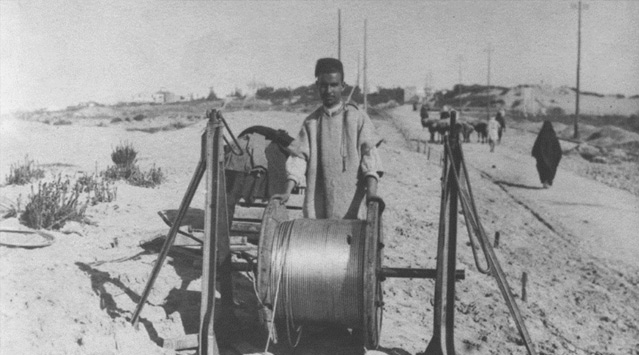TRANSMISSION

Transmission
Short distance urban communications are established, at voice frequencies, using a pair of wires for each communication.
When distance increases, as in long-distance and international calls, attenuation of the voice must be compensated for, and the number of cables must be reduced. This has been made possible thanks to equipment which allows the transmission of a greater number of communications over the same support.
Low frequency repeaters, coaxial cables, coaxial cable repeaters
In order to compensate for attenuation in lines, it was necessary to use amplifiers, which became possible thanks to the application of electronics which then still used valves.
The Second World War played a major role in the transmission of signals, this period saw the development of microwaves. Previously, signals had been transmitted through a pair of wires. From this moment on, coaxial cables began to be used, such as those shown here. These cables comprise two copper tubes, one inside the other, which are isolated from each other by separators.
In order to compensate for attenuation in coaxial cables, repeaters or intermediate amplifiers are needed. These are the objects which you can see at the back of this area.
Optical Fibre
Optical fibre cables are made of very fine conductors of silica dioxide? Their diameter is measured in tens of microns. They allow information to be carried in the form of incredibly brief luminous pulses.
In Morocco, the first optical fibre cables were installed between Rabat and Casablanca via Mohammedia, in 1989.
The first submarine optical fibre cable, called “Eurafrica”, linking Casablanca with the Portuguese city of Sesimbra, came into service in 1992, followed, in 1994, by the submarine communications cable linking Tetouan with Estepona in Spain.
Submarine telegraph cables
In 1847, machinery for covering copper cables with “gutta-percha”, a very good electrical insulator, was developed. These machines allowed for the development of underwater telegraph cables like the one you are looking at now. In 1852, the first cable between England and France was laid across the English Channel. Seven years later, a cable was established between Tarifa and Ceuta.
In 1865, employees of the Spanish Telegraph Company proposed linking the peninsula to the Canary Islands via a land line between Tangier and Mogador. This line passed through Larache, Rabat and Casablanca, and they also installed two short submarine cables. The first crossed the Straits of Gibraltar, and the second linked Essaouira (also known as Mogador) with the island of Lanzarote in the Canaries.
Finally, note that before 1910, several cables were laid in northern Morocco to Cadiz, Gibraltar, Estepona and the Algerian cities of Oran and Nemours.
Submarine telephone cables
Telegraph cables, made up of a single conductor, were replaced in the mid-20th century, by submarine coaxial telephone cable like the one you can see here. This is a transmission line consisting of a two-conductor cable with submerged repeaters, of the valve type, initially, used to periodically amplify the signal. The first transatlantic cable of this kind, linking the United Kingdom and the United States of America, was the TAT-1, in 1956.
List of analogue Submarine cables
The first analogue submarine cable, which linked Tetouan with Canet in France, was installed in 1966. It had a capacity of 96 telephone circuits.
In 1973, an analogue submarine cable between the Breton city of Penmarch and Casablanca was installed. It had a capacity of 440 telephone circuits.
In 1977, an analogue submarine cable named “Antinea” was installed, linking Morocco to Senegal. It had a capacity of 80 circuits.
The following year, a submarine cable, called “Friendship” which linked Tetouan with Martigues in France, was installed. It had a capacity of 1,985 circuits.
Finally, in 1982, an analogue submarine cable called “Atlas” (which linked Asilah (Morocco) with Burgau (Portugal) was laid. It had a capacity of 1,260 circuits.
List of analogue digital submarine cables with optical fibre
Over the past twenty years, digital optical fibre submarine cables have been installed. The first, dating from 1992, was called “Eurafrica” and connected Casablanca with Portugal and France. It had a capacity of 2,630 telephone circuits.
In 1994, the ONPT (Spanish National Office of Posts and Telecommunications) and Spanish communications firm
Telefonica installed a fibre optic submarine cable linking Tetouan (Morocco) and Marbella (Spain) with a capacity of 7,560 circuits.
This cable uses the SDH (Synchronous Digital Hierarchy) technology which marked an improvement in flexibility, visibility and ease of operation. Above all, it was designed to take into consideration future developments in the subscriber base.
- In December 1999, Morocco brought into service, in Tetouan, an intercontinental cable known as “SEA-ME-WE 3” with a length of 39,000 km which interconnects Morocco with 33 countries.
- In July 2007, Maroc Telecom brought into service an optical fibre submarine cable known as “Atlas Offshore” linking the city of Asilah (Morocco) with Marseille in France. This has a total length of 1,634 km and can handle more than 500,000 simultaneous calls.
- In December 2008, Maroc Telecom joined a consortium of seventeen telecom operators responsible for the construction of an optical fibre submarine cable called ACE (African Coast to Europe) which offers interconnections with more than 25 countries in Africa and Europe.
- In March 2012, Maroc Telecom installed another optical fibre submarine cable known as “Loukkos”, linking Asilah with Rota and Seville in Spain. It is 187 kms long and has a capacity of 80 Gigabytes per second expandable to 1,280 Gigabytes per second). A Gigabyte is a unit of data storage in computer science.
Cable layer
You may be wondering how so many thousands of meters of cables are laid under water. Well, special boats are used that are equipped with a means for storing, laying and repairing cables. Submarine cables are laid on the seabed or the ocean floor. In shallower areas, or near coasts, they are then buried, using underwater robots, to prevent the cables from getting entangled in fishing nets.

